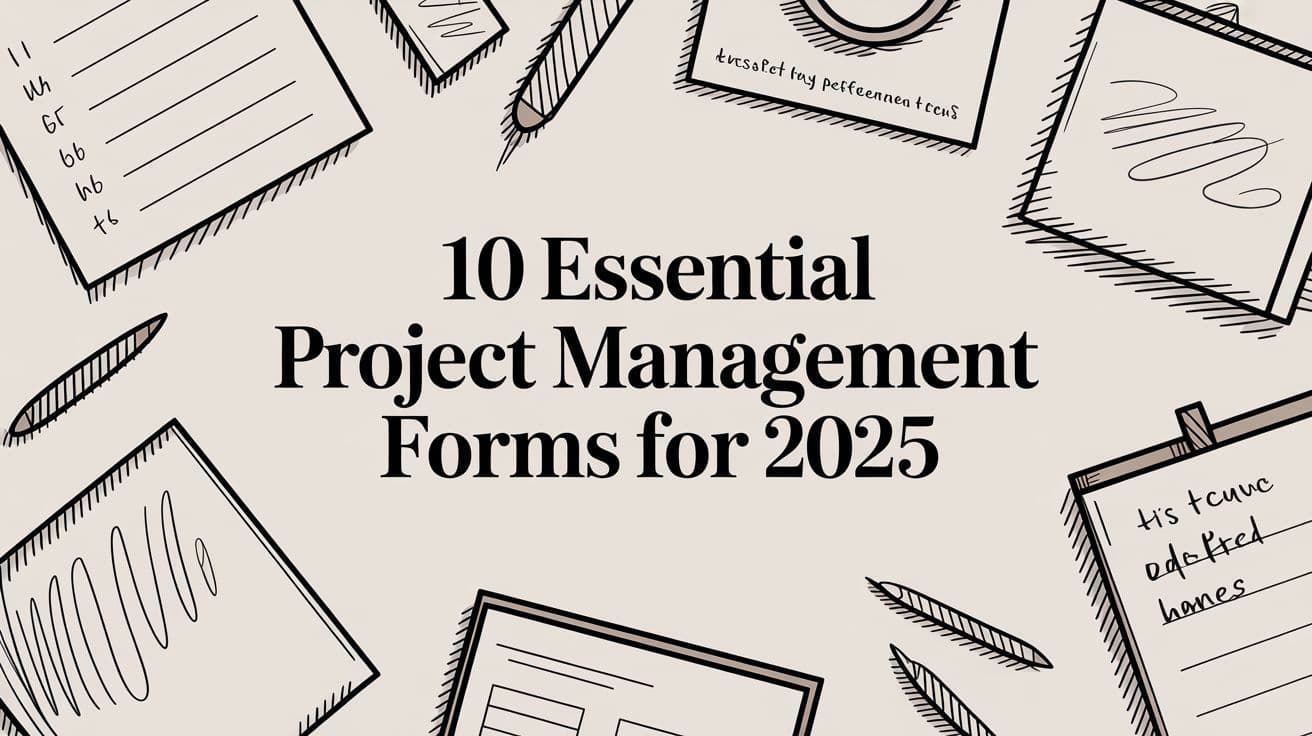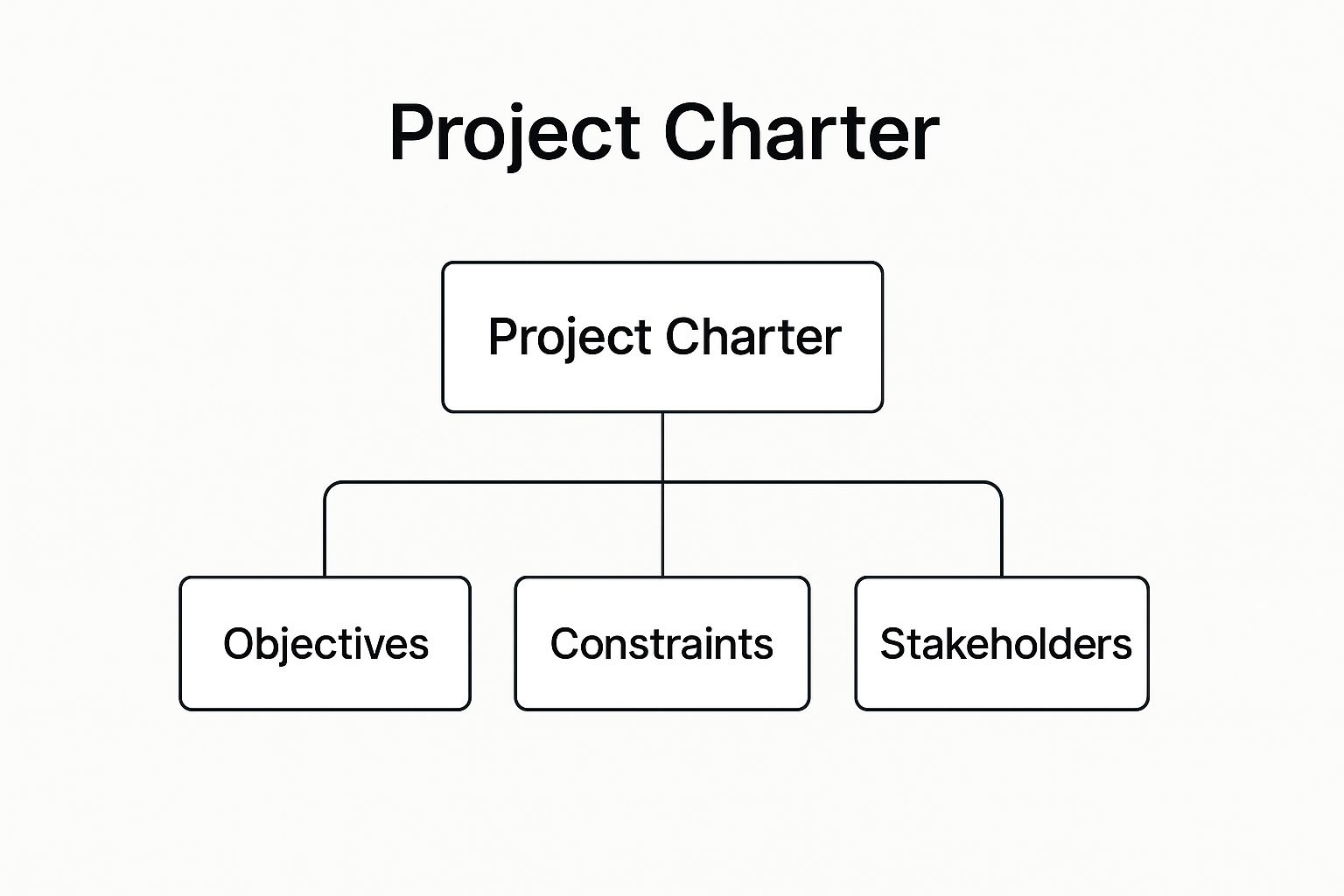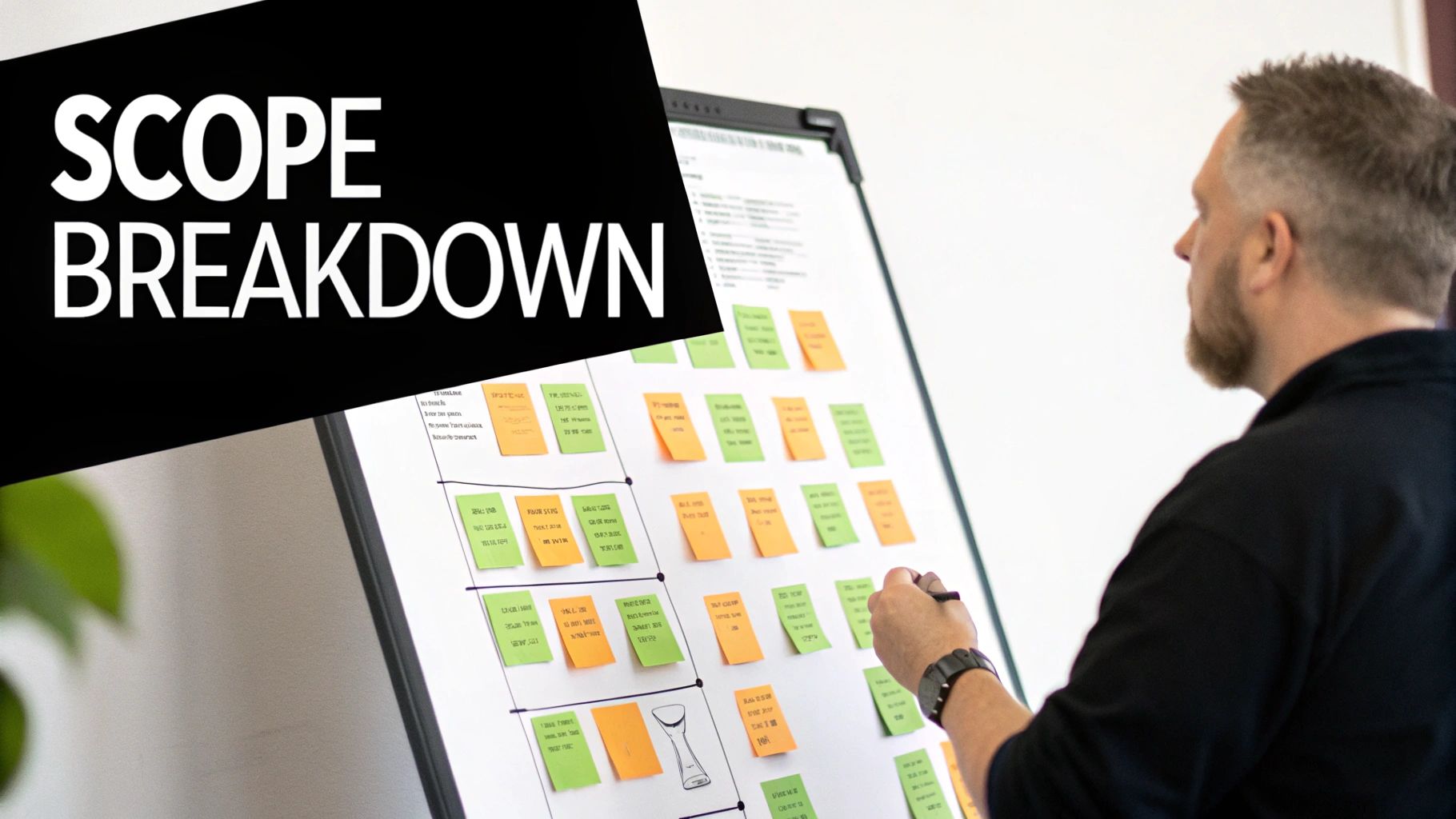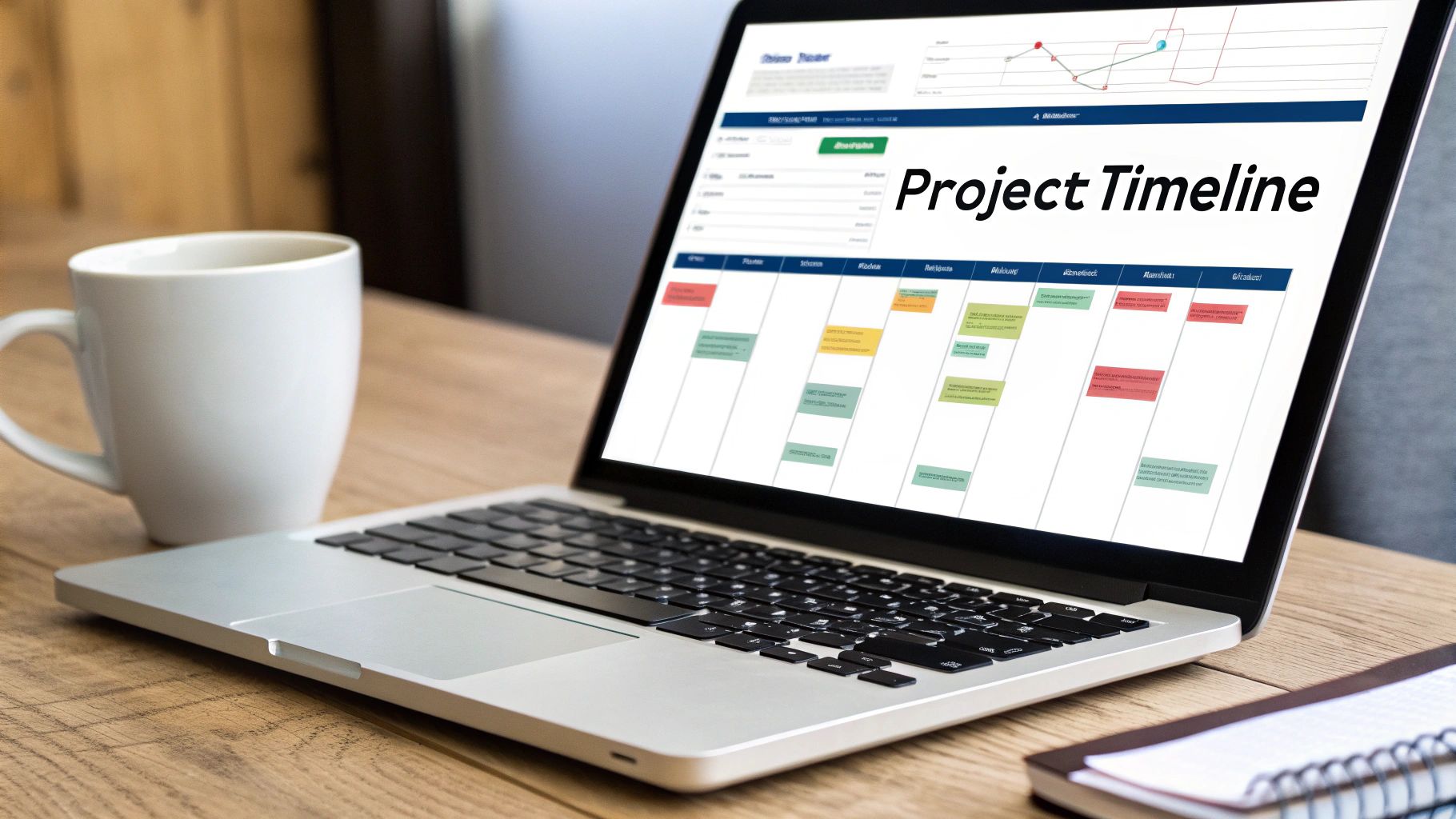
10 Essential Project Management Forms for 2025
Discover 10 essential project management forms you need for success. Learn how to use and customize each one in Notion to streamline your workflows.
Running a project without a structured documentation process is like navigating a ship without a rudder. Communication breaks down, scope creep becomes inevitable, and deadlines are consistently missed. The common solution often involves more meetings or increasingly complex software, but the real fix is simpler: having the right information, in the right format, at precisely the right time. This is where standardized project management forms become indispensable tools.
This guide provides a comprehensive breakdown of the 10 most critical project management forms that create the structure and clarity essential for success. For each document, we will explore its core purpose, detail its key components, and offer actionable steps to implement it as a powerful, dynamic database directly within Notion.
Forget juggling scattered spreadsheets and static documents. By the end of this article, you will have a complete toolkit to transform project chaos into a streamlined, predictable workflow. You will learn how to build a single source of truth for your entire team, ensuring every project stakeholder is aligned and informed from kickoff to completion. Let's get started.
1. Project Charter Template
A Project Charter is the foundational document that formally authorizes a project’s existence. It acts as a contract between the project sponsor, key stakeholders, and the project team, providing the project manager with the authority to apply organizational resources. This is one of the most critical project management forms because it sets the stage for success before detailed planning even begins.
The charter clarifies the project's core purpose, scope, stakeholders, and high-level requirements. For example, a marketing team launching a new campaign would use a simplified charter to get stakeholder alignment on goals and budget, while a construction company would use a detailed version to define strict scope and financial constraints before breaking ground.
Purpose and Key Fields
The primary purpose of a project charter is to establish a shared understanding and secure formal approval. It ensures everyone is aligned from the outset, preventing scope creep and resource misallocation.
Key fields in a standard charter include:
- Project Objectives: Specific, measurable, achievable, relevant, and time-bound (SMART) goals.
- High-Level Scope: Defines what is in and, just as importantly, out of the project.
- Key Stakeholders: Lists individuals or groups impacted by the project, including the sponsor.
- Budget & Resources: An initial estimate of financial needs and key personnel.
- Assumptions & Constraints: Identifies known limitations and assumptions made during initiation.
The infographic below illustrates the hierarchical relationship between the charter and its core components.

This visualization highlights how the charter serves as the root document from which the project's fundamental pillars-its objectives, constraints, and stakeholders-are formally defined.
2. Work Breakdown Structure (WBS) Template
A Work Breakdown Structure (WBS) is a foundational project management tool that provides a hierarchical decomposition of the total scope of work. It breaks down large, complex projects into smaller, more manageable components called work packages. This is one of the most essential project management forms as it visually organizes and defines the entire project scope, ensuring no deliverables are overlooked.
The WBS acts as a map for the project team. For example, a software development team uses a WBS to break down a new feature into epics, user stories, and specific tasks. Similarly, an event planner might decompose a corporate conference into venue management, speaker coordination, marketing, and attendee registration, with each area further broken down into detailed activities.

Purpose and Key Fields
The primary purpose of a WBS is to clarify the project scope and provide a structured framework for planning, estimating, scheduling, and resource allocation. It creates a clear link between project objectives and the work required to achieve them.
Key fields in a standard WBS include:
- WBS Levels: A hierarchical structure, with Level 1 being the project itself and subsequent levels representing major deliverables and work packages.
- WBS Dictionary: A companion document that details each component, including descriptions, assigned resources, and cost estimates.
- Work Packages: The lowest level of the WBS, representing a specific, deliverable-oriented task that can be assigned and tracked.
- Control Accounts: Groupings of work packages used for performance measurement and cost control.
- Unique Identifiers: A numbering system (e.g., 1.1, 1.2.1) for each WBS element to ensure clear tracking.
3. Risk Register Template
A Risk Register is a critical tool used to identify, analyze, track, and manage potential risks throughout the project lifecycle. It functions as a centralized log of all identified threats and opportunities, detailing their potential impact and the planned responses. This is one of the most proactive project management forms, as it allows teams to anticipate challenges rather than just react to them.
The register is a living document that evolves as the project progresses. For instance, a construction firm uses a risk register to track weather delays, supply chain disruptions, and safety hazards. Similarly, an IT department launching a new system would document cybersecurity vulnerabilities, data migration issues, and potential user adoption problems, allowing them to prepare mitigation plans in advance.
Purpose and Key Fields
The primary purpose of a risk register is to systematically manage uncertainty and increase the likelihood of project success. By formally documenting risks, teams can prioritize them, assign ownership, and develop effective strategies to either minimize threats or capitalize on opportunities.
Key fields in a standard risk register include:
- Risk ID & Description: A unique identifier and clear, concise description of the risk.
- Probability & Impact: An assessment of how likely the risk is to occur and the severity of its effect, often scored on a scale (e.g., 1-5).
- Risk Score: The product of probability and impact, used to prioritize risks.
- Risk Response Plan: The specific actions to be taken (e.g., Avoid, Mitigate, Transfer, Accept).
- Risk Owner: The individual responsible for monitoring the risk and executing the response plan.
4. Change Request Form Template
A Change Request Form is a formal document used to propose, document, and track modifications to a project's scope, schedule, or budget. It ensures that any deviation from the established baseline is carefully evaluated and approved, preventing uncontrolled scope creep. These project management forms are vital for maintaining control and alignment when project variables inevitably shift.
This structured process is critical across various industries. For instance, a software development team uses it to manage new feature requests mid-sprint, while a construction project relies on it to document design changes affecting building specifications. The form acts as a formal record, ensuring all stakeholders are aware of the proposed change and its potential impact before a decision is made.
Purpose and Key Fields
The primary purpose of a Change Request Form is to create a standardized, transparent process for managing project changes. It prevents informal or unapproved alterations that could derail project timelines and budgets, ensuring every modification is intentionally reviewed and documented.
Key fields in a standard change request form include:
- Change Description: A clear explanation of the proposed change.
- Justification: The reason for the change, including the benefits it will provide.
- Impact Analysis: An assessment of how the change will affect project scope, schedule, budget, and resources.
- Submitted By & Date: Identifies who initiated the request and when.
- Approval Status: Tracks the decision (e.g., submitted, under review, approved, rejected, implemented).
This systematic approach transforms potential chaos into a controlled process, safeguarding the project’s original objectives. By centralizing requests, teams can make informed decisions rather than reactive adjustments. You can explore a variety of Notion templates for project management to see how this form can be integrated into a digital workflow.
5. Status Report Template
A Status Report is a regular communication document that provides stakeholders with a snapshot of project health, progress, and key information. It acts as a consistent pulse check, summarizing accomplishments, upcoming activities, and current challenges. This is one of the most essential project management forms for maintaining stakeholder alignment and managing expectations.
The status report ensures transparency and keeps everyone informed without the need for constant meetings. For example, a consulting firm provides weekly status reports to clients on engagement progress, while an IT department might send bi-weekly updates on a major system implementation. The goal is to deliver concise, relevant information on a predictable schedule.
Purpose and Key Fields
The primary purpose of a status report is to foster transparent communication and enable timely decision-making. It highlights progress and flags potential issues before they escalate, ensuring stakeholders have a clear view of the project's trajectory.
Key fields in a standard status report include:
- Overall Status: A quick summary, often using RAG (Red/Amber/Green) indicators for a visual health check.
- Accomplishments This Period: A list of key tasks and milestones completed since the last report.
- Planned Activities Next Period: Outlines the major tasks and goals for the upcoming reporting cycle.
- Issues & Risks: Details any new or ongoing problems, blockers, or potential threats to the project.
- Budget & Schedule Update: A brief overview of where the project stands against its timeline and financial plan.
6. Stakeholder Register and Analysis Template
A Stakeholder Register is a critical document that identifies and analyzes all individuals or groups who can affect or be affected by a project. More than just a contact list, this register assesses stakeholders' interests, influence, and potential impact, forming the basis for a strategic communication and engagement plan. This is one of the most strategic project management forms, as it helps navigate the complex human element of any project.
The register helps you proactively manage relationships and mitigate risks arising from stakeholder conflicts. For example, a software implementation project would use this form to track business owners, end-users, IT teams, and vendors, analyzing their specific needs and influence levels to ensure smooth adoption. Similarly, a public infrastructure project would map community groups, government agencies, and environmental activists to manage expectations and legal requirements.
Purpose and Key Fields
The primary purpose of a Stakeholder Register is to categorize stakeholders and develop tailored engagement strategies. It ensures that communication is targeted and effective, preventing misunderstandings and building support for project objectives.
Key fields in a standard register include:
- Stakeholder Identification: Name, role, and contact information.
- Key Interests & Expectations: What they stand to gain or lose from the project.
- Influence/Power Level: Their ability to impact project decisions and outcomes.
- Interest Level: How much the project's outcome will affect them.
- Engagement Strategy: The planned approach for communication and involvement (e.g., keep informed, manage closely).
7. Lessons Learned Template
A Lessons Learned Template is a structured document for capturing knowledge gained during a project. It transforms project experiences into organizational learning by systematically recording successes, failures, and insights that can improve future performance. This is one of the most valuable project management forms for continuous improvement, ensuring that hard-won knowledge isn't lost when a project ends.
This form is typically completed at project closure or after significant milestones. For instance, NASA extensively documents lessons learned from missions to prevent future accidents, while software companies use them to record technical decisions and their outcomes for future architectural planning. The goal is to avoid repeating mistakes and replicate successes across the organization.
Purpose and Key Fields
The primary purpose is to create a formal repository of project insights that can be shared and applied. It fosters a culture of learning and helps standardize best practices, leading to more efficient and successful projects over time.
Key fields in a standard lessons learned template include:
- What Went Well: A description of successful activities, processes, or decisions.
- What Didn't Go Well: An honest assessment of challenges, mistakes, or inefficiencies.
- Recommendations: Actionable suggestions to improve processes for future projects.
- Impact Analysis: Quantifies the effect of the lesson, such as cost savings or time lost.
- Owner: Assigns responsibility for implementing any recommended organizational changes.
This video explains how to effectively run a lessons learned session, emphasizing the importance of focusing on processes rather than blaming individuals to foster an environment of psychological safety and honest feedback.
8. Project Schedule/Gantt Chart Template
A Project Schedule, often visualized as a Gantt Chart, is a powerful tool that illustrates the project timeline. It displays tasks, their durations, dependencies, and milestones along a calendar-based horizontal bar chart, offering a clear, visual overview of the entire project from start to finish. This is one of the most indispensable project management forms for tracking progress and managing timelines effectively.
For instance, a software development team would use a Gantt chart to map out coding sprints, testing phases, and deployment dates, ensuring each step logically follows the last. Similarly, an event planner would use it to coordinate venue booking, vendor contracts, and day-of-event setup, visualizing all critical deadlines in one place.

Purpose and Key Fields
The primary purpose of a project schedule is to provide a comprehensive roadmap for execution, resource allocation, and progress monitoring. It helps teams understand task relationships and identify the critical path, which is the sequence of tasks that determines the project's total duration.
Key fields in a standard schedule template include:
- Task List: A breakdown of all work required to complete the project.
- Start & End Dates: The planned timeline for each individual task.
- Task Dependencies: Defines the relationships between tasks (e.g., Task B cannot start until Task A is finished).
- Assigned Resources: Indicates who is responsible for completing each task.
- Milestones: Significant events or deliverables in the project lifecycle with a zero duration.
Mastering the use of schedules is a core component of effective time management. You can learn more about how to balance work and time efficiently to improve your project outcomes.
9. Issue Tracking Log Template
An Issue Tracking Log is a centralized document for recording, monitoring, and resolving problems that arise during a project. Unlike risks, which are potential future events, issues are current problems that are actively impacting or threatening project success. This is one of the essential project management forms for maintaining momentum and ensuring accountability.
This log guarantees that obstacles do not fall through the cracks. For example, a software development team uses an issue log to track bugs and integration problems, while an event planner would use it to document and manage vendor cancellations or permit delays, assigning each problem to a team member for resolution.
Purpose and Key Fields
The primary purpose of an issue tracking log is to provide a formal system for identifying and resolving impediments, preventing small problems from escalating into major crises. It creates transparency and a clear path for escalation when needed.
Key fields in a standard issue log include:
- Issue ID: A unique identifier for each issue.
- Description: A clear, action-oriented summary of the problem.
- Priority: The urgency of the issue (e.g., Critical, High, Medium, Low).
- Owner: The single individual responsible for driving the resolution.
- Status: The current state of the issue (e.g., Open, In Progress, Resolved).
- Target Resolution Date: A realistic deadline for fixing the problem.
This systematic approach ensures that every problem is acknowledged, assigned, and tracked until it is formally closed. For those looking to create a robust system, you can learn more about building a professional tracker to manage project issues effectively.
10. Project Budget and Cost Tracking Template
A Project Budget and Cost Tracking Template is a financial management document essential for planning, monitoring, and controlling project expenditures. It serves as the single source of truth for all financial matters, ensuring the project stays within its approved financial limits. This is a critical one of the project management forms as it provides stakeholders with a clear view of financial health and helps prevent costly overruns.
This template goes beyond simple expense logging. For instance, a software development project would use it to track developer hours, infrastructure costs, and software licensing fees against the initial budget. Similarly, a marketing agency would monitor spending on media buys, creative production, and freelance talent to ensure campaign profitability.
Purpose and Key Fields
The primary purpose of a budget tracker is to provide real-time financial visibility and control. It enables project managers to make informed decisions, justify spending, and forecast the final project cost accurately.
Key fields in a standard budget template include:
- Budgeted Costs: The planned expenditure for each task or category, often aligned with the Work Breakdown Structure (WBS).
- Actual Costs: The real money spent to date.
- Committed Costs: Funds that have been approved for an expense but not yet paid (e.g., a signed contract with a vendor).
- Forecast to Complete (FTC): An estimate of the remaining funds needed to finish the project.
- Variance Analysis: The difference between the planned budget and the actual costs, highlighting areas of concern.
- Contingency Reserve: A specific amount set aside to cover unforeseen risks or "known unknowns."
By consistently comparing actuals to the baseline, this template flags deviations early, allowing for corrective action before they escalate. It's an indispensable tool for maintaining fiscal responsibility and delivering value within constraints.
Comparison of 10 Project Management Form Templates
| Template | 🔄 Implementation Complexity | ⚡ Resource Requirements | 📊 Expected Outcomes | 💡 Ideal Use Cases | ⭐ Key Advantages |
|---|---|---|---|---|---|
| Project Charter Template | Medium – requires stakeholder coordination | Moderate – input from sponsors & PM | Formal project authorization, aligned vision | Initiating projects needing formal approval | Clear authority, scope boundaries, early alignment |
| Work Breakdown Structure (WBS) Template | High – detailed decomposition needed | High – requires experienced planners | Clear scope definition, work packages | Complex projects needing structured scope | Prevents work overlook, aids scheduling & budgeting |
| Risk Register Template | Medium – ongoing updates required | Moderate – risk analysis & monitoring | Proactive risk management, prioritization | Projects with high uncertainty or complexity | Enhances risk awareness, supports decision-making |
| Change Request Form Template | Low to Medium – standard form & workflow | Low to Moderate – impact analysis needed | Controlled changes, maintained baselines | Projects with defined baselines needing change control | Prevents scope creep, audit trail for decisions |
| Status Report Template | Low – routine preparation | Low – data collection & communication | Stakeholder transparency, progress tracking | All projects requiring regular stakeholder updates | Facilitates accountability, early problem detection |
| Stakeholder Register & Analysis Template | Medium – detailed stakeholder mapping | Moderate – requires stakeholder input | Targeted communication, stakeholder management | Projects with multiple or complex stakeholders | Improves buy-in, manages resistance |
| Lessons Learned Template | Low to Medium – facilitated sessions | Low – team involvement | Organizational learning, process improvement | All projects, especially recurring or improvement-focused | Prevents repeated mistakes, captures best practices |
| Project Schedule/Gantt Chart Template | Medium to High – task dependencies & detailing | Moderate – requires scheduling expertise | Visual timeline, dependency tracking | Projects with sequential/interdependent tasks | Identifies critical path, aids resource allocation |
| Issue Tracking Log Template | Low to Medium – ongoing updates | Low – issue reporting & resolution tracking | Issue visibility, accountability | Complex projects with many obstacles | Prevents forgotten issues, supports escalation |
| Project Budget & Cost Tracking Template | Medium to High – detailed financial tracking | Moderate to High – cost data & analysis | Financial control and forecasting | Budget-sensitive or fixed-price projects | Early overrun detection, supports earned value analysis |
From Forms to Flow: Building Your Project Command Center
We've journeyed through the essential toolkit of project management: the ten foundational forms that bring structure, clarity, and control to any initiative. From the initial high-level vision of the Project Charter to the granular detail of the Work Breakdown Structure, and the critical oversight provided by the Risk Register and Issue Log, each document serves a distinct and vital purpose. These are not mere bureaucratic hurdles; they are the architectural blueprints for success.
The true transformation, however, doesn't come from simply filling out static templates. It emerges when you integrate these project management forms into a dynamic, interconnected system. Imagine your Change Request Form automatically updating your Project Schedule, or your Status Report pulling real-time data from your Budget Tracker. This is the power you unlock when you move beyond disconnected documents and build a centralized project command center.
The Shift from Static Documents to a Dynamic System
The core takeaway is this: the value is in the process, not just the paperwork. A completed Project Charter is useful, but a living charter that stakeholders can easily reference and that links directly to your WBS is powerful. A Risk Register in a spreadsheet is a good start, but a Notion database that connects risks to specific tasks and owners creates true accountability.
By translating these traditional project management forms into interconnected databases within a tool like Notion, you achieve several critical advantages:
- A Single Source of Truth: No more hunting for the latest version of a document. Everyone works from the same live, updated information, from stakeholders to team members.
- Automated Insights: When your Issue Log, Budget Tracker, and Schedule are linked, you can create dashboards that provide an immediate, holistic view of project health without manual compilation.
- Enhanced Collaboration: Team members can comment directly on tasks, update their progress in real-time, and see how their work impacts the bigger picture, fostering a sense of shared ownership.
Your Actionable Next Steps
Mastering these concepts is the difference between simply managing tasks and strategically leading projects to successful completion. It allows you, whether you're a freelancer managing client work or a small agency juggling multiple initiatives, to operate with the efficiency and foresight of a much larger organization.
Your immediate goal should be to move from theory to practice. Don't just download a template; implement it within a system. Start small. Choose one project and build out a basic Risk Register or Stakeholder Analysis in Notion. Connect it to your task list. As you see the benefits, you can progressively integrate more of the project management forms we've discussed, building a comprehensive and customized workflow that scales with your ambitions. This proactive approach turns administrative tasks into strategic assets, ensuring every project not only gets done but gets done right.
Ready to skip the setup and jump straight to a fully integrated system? The Flowtion Complete Bundle is a professionally designed, end-to-end productivity suite that instantly transforms your Notion workspace with battle-tested templates for everything we've discussed. Stop building from scratch and start managing projects with clarity and confidence today by exploring the Flowtion ecosystem.
Related Articles
How to Improve Work Efficiency with Simple Wins
Discover how to improve work efficiency with practical, actionable strategies. Stop being busy and start being productive with our step-by-step guide.
Notion Productivity Templates: Best Workflow Guide
Discover how to find, customize, and integrate Notion productivity templates to build a powerful workflow that streamlines your tasks and boosts efficiency.
Goal Planner Templates That Turn Ambitions Into Achievements
Discover how goal planner templates turn ambitions into achievements. Learn to choose, customize, and apply the perfect template for lasting success.
Did you like this article?
Discover our premium Notion templates that will help you implement these productivity systems immediately.